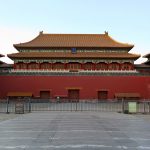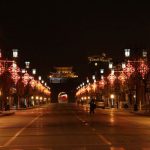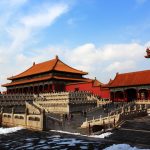 The Temple of Great Awakening, also called Temple of Enlightenment or Dajue (in Chinese) Temple, is located on the southern slope of Yangtai Mountain in the western suburb of Beijing.
The Temple of Great Awakening, also called Temple of Enlightenment or Dajue (in Chinese) Temple, is located on the southern slope of Yangtai Mountain in the western suburb of Beijing.
Its construction was started in 1068 in the Liao Dynasty (916-1125) and its original name was Clear Water Temple (Qingshui Yuan in Chinese) for there was a clear spring flowing through the temple. In the Ming Dynasty (1368-1644), the temple changed its present name. It was open to the public in 1992. Since 1997, the Magnolia Festival has been held every April as well as other exhibitions and cultural activities. In 2006, the Temple of Great Awakening was listed as an important cultural relic site under state-level protection.
Constructed according to the mountain contour, the Temple of Great Awakening faces east, reflecting the construction arrangement of worshipping the sun by the Liao People. Covering an area of 6,000 sq meters (0.6 hectare), it is composed of temples in the middle, temporary palaces for emperors in the south and dwellings for monks in the north.

Main Architectures in the Middle Section
Entering the front gate of the Temple, first you will see the Hall of Heavenly Kings dedicated to Maitreya Bodhisattva. The statues of Maitreya and four Bodhisattvas are housed in the middle of the hall. Gongde Pond (Setting-fish-free Pond) is located in the west of the courtyard. Water flows into the pond through the mouths of stone-engraved animals. These stone sculptures enjoy a history of almost one thousand years. By the east side of the stone bridge over the pond grows an ancient cypress tree, which amazes people by the needle-point leaves and the broad leaves growing in the crown from the vines which parasitize the tree. Pavilions with stone tablets inside, the bell tower and the drum tower are situated in the northern and southern side of the courtyard.
The main hall, called the Hall of Sakyamuni (Da Xiong Bao Dian in Chinese), is the second hall located in the middle section of the Temple of Great Awakening. A wooden gilded statue of Sakyamuni sits on a stone altar. A horizontal tablet inscribed by Emperor Qianlong of the Qing Dynasty (1644-1911) is hung above in the hall, and plaques inscribed by the Empress Cixi of the Qing Dynasty can be also seen in the hall.
Behind the Hall of Sakyamuni is a hall where Amitabha is enshrined. The Hall of Amitabha is built on a high platform and surrounded by white marble rails. The tablet inscribed by Emperor Qianlong is hung over the gate. One Buddha and two Bodhisattvas are worshiped in the hall.
By the north and south sides of the hall stand two stone tablets. The northern one was built in 1478 in memory of the reconstruction of the Temple of Great Awakening, while the southern one was built in 1504 and its inscription records the reconstruction in 1478.
The King of Ginkgoes is also worth visiting. There are two ginkgoes growing in front of the Hall of Amitabha and the tree by the north with a height of 25 meters (82 feet) and a girth of 7.5 meters (8.2 yards) is over 900 years old and has been described in many poems.
Hall of Great Compassion (Da Bei Tang in Chinese) is where sutras were deposited. By the northwest of the hall is seated a stone tablet of the Liao Dynasty. This south-facing tablet, 2 meters (6.6 feet) high and one meter (1.1 yard) wide, was inscribed in 1068 and now part of the inscriptions has become blurred over the years. It is the most precious historic relic in the Temple.
Siyi Hall in the Southern Section
Siyi Hall, also South Magnolia Hall was built in the Qing Dynasty. It is famous for its ancient magnolia. This magnolia, with a height of over 10 meters (33 feet), is more than 300 years old, and is the biggest tree of its kind in Beijing. It blossoms in April and the white flowers are as big as an adult’s fist. In the courtyard, a huge cypress tree, parasitized with a plum tree, is also one of the highlights of the Temple.
North Magnolia Hall in the Northern Section
Monks’ dwellings are located in the northern section of the temple, and the North Magnolia Hall) is worth visiting. In the courtyard of the hall, there is a grey tank carved by a big marble stone 2 meters (2.2 yards) long, 1.3 meters (1.4 yard) wide and 1 meter (3.3 feet) high. Three characters of Bi Yun Qing (meaning clear water) were engraved on it.
Architectures in the Back
Jialing Tower housing the relics of Monk Jia Ling sits at the highest point of the Temple. Built in 1747, this tower is 12 meters (39.4 feet) high like an inverted bowl and its base was engraved with lotus and impeded with carved brickwork. A pine tree and a cypress tree grow by the two sides, as if they were embracing the ancient tower. Holy Spring Tank is located behind the tower. Water flows through the dragon mouth. In ancient China, people believe the spring was granted by the Dragon King, so a two-floor hall for the king was built by the side of the tank.










